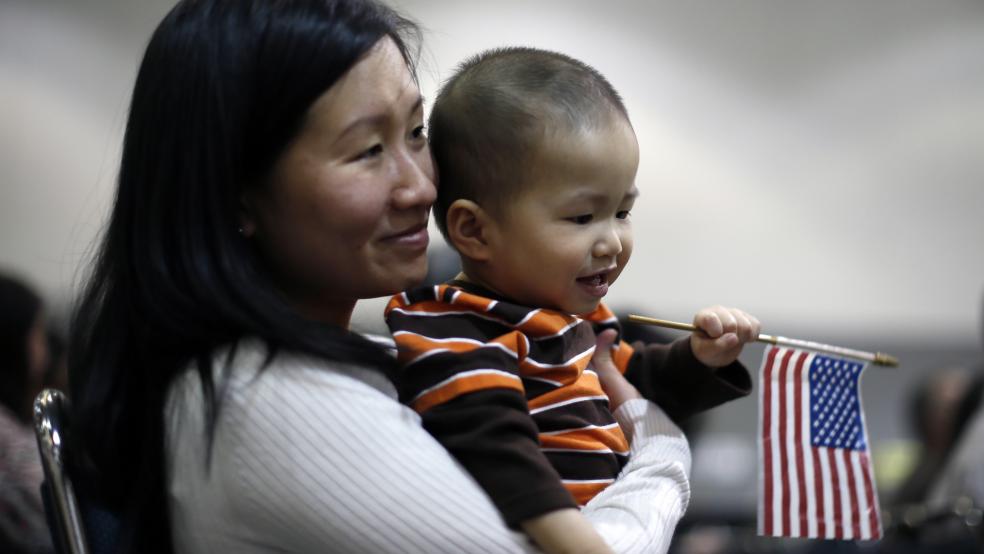U.S. birth rates fell to record lows in 2013, but married women and older women are starting to have more babies, new federal data shows.
The number of births has been dropping since 2007, right around when the recession began, but they've dropped at a slower pace since 2010, according to the National Center for Health Statistics. There were 3,932,181 registered births in the United States in 2013, a 1 percent drop from the previous year and down from 4.3 million in 2007.
There's a couple interesting things to note in this latest report, which serves as just the latest sign that married people, who already tend to be richer and better-educated, are enjoying advantages over people who aren't married. And this is especially true for older women.
More Married Women Are Having Babies
After decreasing 5 percent between 2007 and 2010, the birth rate for married women is on the upswing. It increased 1 percent between 2012 and 2013 to 86.9 births per 1,000 married women. That's up 3 percent since 2010, and it's the same rate as 2008.
Related: The 10 Most Livable Cities in America
But the birth rate for unmarried women, which dropped for the fifth straight year, was down 2 percent between 2012 and 2013 to 44.3 per 1,000 unmarried women. The share of all births by unmarried women dropped to 40.6 percent, which is down from the highest share of 41 percent in 2009. Meanwhile, birth rates for unmarried women in their 30s have reached historic peaks. At the same time, non-marital births to mothers in "cohabiting unions" with a partner have been increasing over the past decade, up from 41 percent in 2002 to 58 percent.
Older Women Are Also Having More Babies
The average age of the mother at first birth, another key metric, also increased from 25.8 years in 2012 to 26 years in 2013 — a record high. That, the NCHS says, is a reflection of the decline in births among teenagers and women in their 20s — which hit record lows — and more women having their first babies in their 30s and 40s. The birth rate for women ages 35-39 was up 2 percent from 2012 and was the highest rate for the group in 50 years.
Women with more education tend to be the ones waiting longer to have babies, according to a new Pew Research Center analysis. Among women ages 40-50 with a master's degree or more, the median age they first become mothers is 30. For women with a high school diploma or less the median age is 24.
There's More Older Dads, Too
The birth rate for fathers ages 35-39 was 66.6 percent, compared to 42.8 percent in 1980. Among those ages 40-44, the rate was 27.0, compared to 18.8 in 1980.
Teen Birth Rate Continues to Plummet
The declining teen birth rate dropped another 10 percent between 2012 and 2013, with the United States now recording 26.5 births per 1,000 teenagers between 15 and 19 years old. The U.S. teenage birth rate, which has seen historic declines, still exceeds other developed nations, but it's down 47 percent since 1991.
Related: Teen Birth Rate Drops by Half
Twins at Record High
There were 33.7 twins per 1,000 births, way up from 18.9 in 1980. Experts think it's because older parents are relying on fertility therapies, which can increase the odds that parents will have twins or triplets.

Just three states saw birth rates increase in 2013: Florida, North Dakota (perhaps from the fracking boom?) and Texas. There were declines in 12 states, while the rate was virtually unchanged in the rest.
There's an important economic story behind these numbers. The recession saw a decline in births, with Americans feeling less secure about their financial situations. The continuing decline in the birth rate for unmarried women could indicate that they're not experiencing the same economic relief from the recovery.
There are broader implications for America's future. The current fertility rate is at 1.86 births per woman, which is below the ideal 2.1 births per woman rate for industrialized countries. If the trend continues, it could mean a smaller tax base and fewer workers.
This article originally appeared in The Washington Post.
Read more at The Washington Post:
Name These Cities Just by Looking at Subway Maps
2014 Was Hottest Year on Record
Tavenner Is Stepping Down





